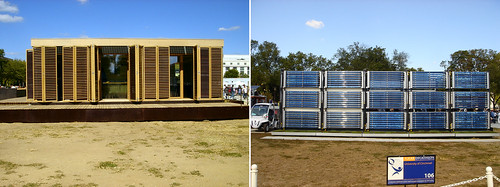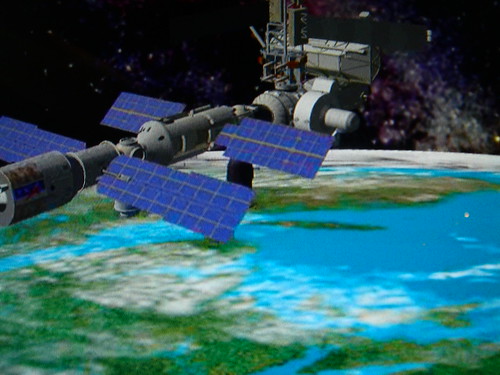
There are few things more exciting than the idea of living off the grid. Access to power, water and food is historically a function of interdependence: it takes whole societies to build infrastructure for the creation, maintenance and distribution of these necessities. The motivation behind the closed loop, small scale, sustainable developments in architecture and design is less the idea that, with a smaller impact, we'll be fullfilling some kind of moral, karmic obligation to a diffuse concept like the environment. What's exciting about living off the grid is the implied mobility and autonomy that go along with the decoupling from large scale, outdated, static infrastructures: no foreign oil, and no powerlines. Living green implies independence, a freedom to be and to go that wasn't possible before.
The Solar Decathlon, an annual competition between student teams to build the most efficient prefab sunpowered house, should be the hottest architecture event around. But the obsession with kilowatt/hours on the engineering side, and a constant fallback to default design decisions in the architecture of the things has, with few exceptions, kept it from making the crucial leap into consciousness and imagination that the implications of the technologies would promise.
As my girlfriend overheard a woman say into her cellphone: 'They keep trying to explain every little thing to you, when I all I want to do is just look at this stuff!', and it's not just the student tour guides that get all didactic. The structures themselves are jumping all over the place to overemphasize their theme with all the familiar emblems: the trellis, the plant wall, the water tank, the obligatory shipping container, and of course, the ubiquitous huge shed roof with solar panels slanted due south at the optimal angle. It's a disappointingly bland kit-of-parts architecture, assembled to an instruction manual provided by Dwell Magazine.
Some of the best work here downplays the theme, like the simple, slatted box by the students at the Technische Universitat Darmstadt in Germany, where the photovoltaics are dissolved and distributed throughout the louvres. Other teams benefit by intentionally turning the volume up to eleven, pushing the technical aesthetics into straight sci-fi territory, like the moonbase south facade (complete with rover) by the University of Cincinnati.

What's missing here (apart from the conspicuous and regrettable absence of several well-known architecture schools) is the kind of intention and aspiration that can give engineering an emotional impact. Confirmation is no further than several hundred yards down the National Mall at the Smithsonian Air & Space Museum.
The Cold War and the Space Race have done at least as much for aesthetics as they have for technology. Two nuclear missiles greet visitors in the atrium here: an American Pershing II and a Soviet SS-20. Decommisioned in 1987 at the signing of the Intermediate Range Nuclear Forces treaty, these two artefacts could hardly be more different in the expression of their intent. The American missile is a pure cartoon of optimism and righteousness: Chesely Bonestell by way of GI Joe. The Soviet missile is all inscrutable alien menace: a triple-lobed point and a body covered in Cyrillic hieroglyphs. Two aesthetics for two different Cold War strategies: the American push to unify from within, and the Soviet intent to menace from without.
One hall down, at the Space Race exhibit, the centerpiece is a recreation of the first meetup between Soviet and American craft in orbit: the docking of an Apollo and a Soyuz module in 1975. This event, ostensibly a scientific experiment, was largely a mediated political manouver signifying détente, the relaxing of Cold War tensions. Again, the contrast is clear, the American Apollo module is an orbiting SUV, bulky and Euclidean. In orbit, where size and weight are at a premium, this is literally Conspicuous Consumption of Space. It dwarfs the sinister, buglike Soyuz, which nevertheless seems to be feeding off the American spacecraft like a parasite.

With solar power, air and water recycling, and even some of the first attempts at onboard farming, what could be more sustainable than a spaceship? It's a mobile, autonomous, closed loop system that does even more than sustain, it produces: political consensus, military power, science fiction. Spaceships make little kids want to study physics so they can become astronauts.
If sustainability is the assurance that the future will be as good as the past, don't we really want more than that? A goal should be framed, not in terms of sustainability, but in terms of productive excess. We don't want the same, we want more. Efforts such as the Solar Decathlon fail to the extent that they refuse to acknowledge the productive power of the imagination, not only for its capacity to make good design, but for its ability to involve people in global change on an emotional level.

[[Edit 10/15: rereading this, it sounds a little more negative than I had maybe intended. Having worked on a collaborative design/build while in school myself, I know how hard it is to generate and maintain a big idea through that process, not to mention all the hard work these student teams put out there just to make these things. Big shoutouts and respect to all the students involved, I'm jealous and ashamed that my school isn't among them!]]

9 comments:
I haven't seen the projects in person, only online, but it strikes me that while the projects might not live up to our expectations, they are pretty damn good.
After studying the LEED for homes guidelines and case studies for another project last week, these solar decathlon projects are certainly far more innovative, both technically and architecturally.
They also look far better than the projects from the last few years. In previous years, many entries were submitted from engineering-only teams without any architecture students. Most of the entries this year were certainly the product of multi-disciplinary teams, which should be commended.
Yeah, it's pretty obvious that this is percolating through from the engineering side of things, but whether or not this year's entries look better than previous year's, they can still get better yet, and they're going to have to if the battle for hearts and minds matters at all.
This is the problem: even the 'Market Viability' category broke things down to the numbers: construction cost and potential sale price. That's not gonna mean jack if nobody wants to buy your house because it doesn't mean anything.
In the end, I really don't care if they meet or exceed LEED standards. The house has to look towards a new way of living, and all that that implies, or else it's really not worth doing.
(and don't judge the houses by the renderings you see on the website, the execution comes up short in most cases)
((don't get me wrong, I'm not being negative or critical just for its own sake, I really wanted this to be cool, that's why it's all the more disappointing))
Yeah I get your drift... and appreciate your argument. It is critical to fight for the role and relevance of architecture, design and vision. But it seems like the program is moving -though slowly- towards a new architecture. I know the early UMD entries were engineering-only efforts. Let's hope that the measure of success can also evolve into a more holistic evaluation that considers technical, aesthetic and experiential parameters.
On another note, any idea what happens to all of the materials and plants after it's all over? And does the plant material really survive through the course of the exhibition?
We used to tell which way was north from the side of trees on which moss grows. Now it's which way the satellite dishes point. Another interesting post, btw.
Goodness, there is really much useful material here!
It cannot have effect in actual fact, that is what I think.
Very effective material, lots of thanks for this article.
I completely agree with anything you have printed.
I found so much worthwhile material above!
Post a Comment